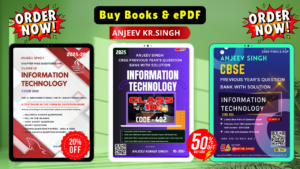Class 10 Info Tech Code 402 NCERT Solution
Unit 1 – Digital Documentation (Advanced)
Q1. What are Styles? What are the advantages of using styles?
Answer: A style is a set of formats that you can apply to selected pages, text, frames, and other elements in your document to quickly change their appearance.
The advantages of using styles are :
1. Styles help us to apply consistent formatting to the documents.
2. Using styles we can easily change the existing format.
3. Styles make major formatting changes simple.
Q2. Give any four styles supported by OpenOffice.org
Answer: Four Styles supported by OpenOffice.org are.
1. Page styles – include margins, headers and footers, borders, and backgrounds.
2. Paragraph styles – control all aspects of a paragraph’s appearance, such as text alignment, tab stops, line spacing, and borders.
3. Character styles – affect selected text within a paragraph, such as a font and size of text, or bold and italic formats.
4. Numbering styles – apply similar alignment, numbering, or bullet.
Q3. How can we create our own styles?
Answer:- We can create new styles by following two ways :
1. Creating new styles from the selection.
2. Dragging And Dropping To Create A Style.
Q4. Explain any four Graphic filters.
Answer:- Four graphic filters are :
- Invert: Inverts the color values of a color image or the brightness values of a grayscale image.
- Smooth: Softens the contrast of an image.
- Sharpen: Increases the contrast of an image.
- Posterize: Makes a picture appear like a painting.
Q5. Explain Image Cropping.
Answer:- When you are interested in a section of the image for the purpose of your document, you may wish to crop (cut off) parts of it. Right click on image and select Picture from the pop-up menu. In the Picture dialog box, select the Crop page and select the part from left, right, top and bottom which you want to remove.
Digital Documentation NCERT Solution
Q6. List any three methods of inserting images in a text document.
Answer:- Three methods of inserting images in a text document are :
a. Drag and Drop
b. Inserting An Image From The Clipboard
c. Inserting An Image Using A Scanner
Q7. What do you understand by the terms:
a. Text Wrapping b. Anchoring
Answer:-
a. Text wrapping refers to the relation of graphics to the surrounding text, which may wrap around the graphic on one or both sides, or be overprinted behind or in front of the graphic.
b. Anchoring: It refers to the reference point for the graphics. This point could be the page, or frame where the object is. An image always has an anchor point.
Q8. What are templates? What are the advantages of using templates?
Answer:-
A template is a model that you use to create other documents. For example, you can create a template for business reports that have your company’s logo on the first page. When you create a new document from this template will all have your company’s logo on the first page.
One of the major advantages of using templates is the ease of updating styles in more than one document. Another advantage is that it also saves your time.
Q9. What is the difference between styles and templates?
Answer:-
| Styles | Templates |
| A style is a set of formats that you can apply to selected pages, text, frames, and other elements in your document to quickly change their appearance. | A template is a model that you use to create other documents. |
| Styles help to keep formatting consistent in the entire document | Templates help to keep formatting consistent across multiple documents |
Class 10 Info Tech Digital Documentation NCERT Solution
Q10. Explain different ways of creating a template
Answer:-
Templates can be created in the following two ways
A. Creating A Template From A Document: To create a template from a document:
- a. Open a new or existing document of the type you want to make into a template.
- b. Add the content and styles that you want.
- c. From the main menu, choose File > Templates > Save.
- d. The template dialog box opens.
- e. Type the name of the template.
- f. Click OK to save the new template
B. Creating A Template Using a Wizard :
You can use wizards to create templates for letters, faxes, agendas, presentations, and Web pages.
To create a template using a Wizard:
- From the main menu, choose File > Wizards >Letter
- Select the Page Design, and click on the next button.
- Select the items to be printed and click on the next button.
- Decide the Receiver and Footer, and click on the next button.
- Write the Name of the Template and click on the Finish button.
- Now you are ready to create any document with the help of this template.
Digital Documentation Class 10 IT Code 402
Q11. Explain Mail Merge.
Answer: A mail merge is a way to take a letter you’ve written and send it to a whole bunch of people, personalizing it with information about them so they might think that you typed that letter personally for them. In short, it’s a way to be personal, yet efficient.
Q12. What are the advantages of Mail Merge?
Ans. The advantages of mail merge are :
- Mail-merge saves our time and effort.
- Helps to create multiple personalized letters in very less time.
- Mail merge helps in sending the same documents to many people i.e. consistent formatting in all the letters.
Q13. Give examples of databases in which the Data Source can be created.
Ans. Databases in which the Data Source can be created are :
- MySQL
- MS – Access
- OpenOffice base
- Oracle
Class 10 Info Tech NCERT Book Exercise Solution
- Chapter 14 Workplace Quality Measures IT Code 402 NCERT Solution

- Chapter 13 Health Safety and Security at Workplace IT Code 402 Book Solution Class 10

- Chapter 12 Forms and Reports IT Code 402 Book Solution Class 10

- Chapter 11 Queries in Base IT Code 402 Book Solution Class 10

Class 10 Info Tech 402 Unit 4 Web Application and Security Question Answer and MCQ’s
- Class 10 IT 402 Web Application and Security Revision Notes – Download pdf
- Class 10 Info Tech 402 Unit 4 Web Application and Security Notes download pdf
- Class 10 IT Code 402 Unit 4 Web Applications Security Session 11 Protect Health and Safety at Work Question Answer
- Class 10 IT Code 402 Unit 4 Web Applications Security Session 10 Prevent Accidents and Emergencies Question Answer
- Class 10 IT Code 402 Unit 4 Web Applications Security Session 9 Maintain Workplace Safety Question Answer
- Class 10 IT Code 402 Unit 4 Web Applications Security Session 8 Internet Security Question Answer
- Class 10 IT Code 402 Unit 4 Web Applications Security Session 7 Online Transactions Question Answer
- Class 10 IT Code 402 Unit 4 Web Applications Security Session 6 Using Offline Blog Editors Question Answer
- Class 10 IT Code 402 Unit 4 Web Applications Security Session 5 Creating and Publishing Web Pages Blog Question Answer
- Class 10 IT Code 402 Unit 4 Web Applications Security Session 4 Chatting with a Contact Google Talk Question Answer
- Class 10 IT Code 402 Unit 4 Web Applications Security Session 3 Introduction to Instant Messaging 50+ Question Answer
- Class 10 IT Code 402 Unit 4 Web Applications Security Session 2 Networking Fundamentals 50+ Question Answer
Class 10 Info Tech 402: Unit 3 – DBMS (Database Management System) Question Answer and MCQ’s
- Class 10 IT 402 RDBMS – SQL Commands in OpenOffice Base Notes
- Structured Query Language (SQL ) in OpenOffice.org Base
- Class 10 Info Tech 402 Unit 3 RDBMS Database Management System Notes Download PDF
- Class 10 Info Tech Unit 3 RDBMS Session 5 – Create Forms and Reports using Wizard 50+ Question Answer
- Class 10 Info Tech Unit 3 RDBMS Session 4 – Retrieve Data Using Query 50+ Question Answer
- Class 10 Info Tech Unit 3 RDBMS Session 3 – Perform Operations On Tables 50+ Question and Answer
- Class 10 Info Tech Unit 3 RDBMS Session 2 – Create and Edit Tables Using Wizard & SQL Commands 50+ Question Answer
- Class 10 Info Tech Unit 3 RDBMS Session 1 Appreciate Concept of Database Management System 50+ Question Answer
- Class 10 Info Tech RDBMS Session 2 Create and Edit Tables Using Wizard and SQL Commands MCQs
- Class 10 Info Tech Unit 3 RDBMS Session 1 Appreciate the Concept of Database Management System MCQs
By Anjeev Kr Singh – Computer Science Educator
Published on : August 9, 2021 | Updated on : April 16, 2024













